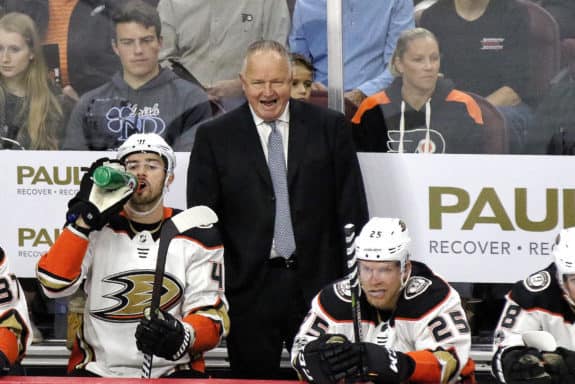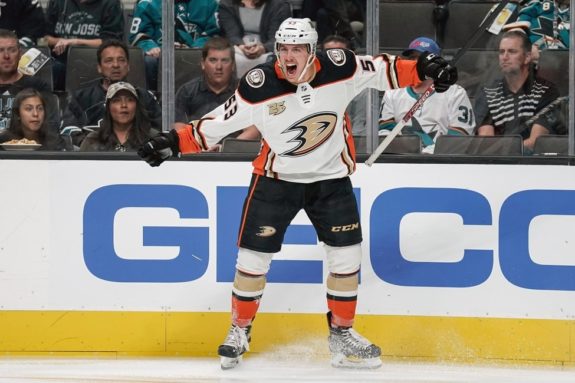![]()
The Anaheim Ducks have been treading water with their figurative heads bobbing just above and below the playoff waterline since a few weeks into the season. If Anaheim wants to stay above the playoff line — they’re currently third in the Pacific Division, simultaneously one point from the top spot and two points from being out of the playoffs after last night’s win over Florida — the Ducks will need to make a major adjustment to decrease the number of penalties they take and increase their success on the power play. That won’t be easy.
One Step Forward, Two Steps Back
Once again, the Ducks are one of the most penalized teams in the NHL. They trail only Vancouver in “times short-handed” playing at least a man down 94 times this season and rank 29th in the league in short-handed time-on-ice at 151 minutes.
Though Anaheim has a reputation for taking a lot of penalties, that hasn’t always been the case during this young season. Two weeks into the 2018-19 campaign, Elliot Teaford of the OC Register highlighted the team’s new, uncharacteristic discipline, pointing out that, at the time, Anaheim had the third-lowest average penalty minutes in the league and that it may be a sign that they’ve taken to their new, faster style of play.
In that article, head coach Randy Carlyle confirmed that the Ducks have focused on the speed aspect of their game.
“I think we’re a different type of hockey club,” Coach Randy Carlyle said. “We’ve stressed that we want to be more of a skating team.” (from ‘Mighty disciplined Ducks staying out of the penalty box, The OC Register – 10/17/18)
Unfortunately, the Ducks have regressed in a major way and now they’re once again one of the league’s most penalized teams.
Anaheim has drawn more penalties than they’ve committed in only four of the season’s 27 games. It’s not a sign that the NHL has it out for the Ducks, it’s a sign that the team has failed in speeding up its pace of play.
Ducks Getting Penalties in the Slow Lane
The Ducks’ lack of speed is a well-known problem and their consistent march to the penalty box since mid-October shows they haven’t adjusted well. After two weeks they were 15th in the league in times short-handed. By Nov. 14, they were short-handed the sixth-most in the NHL. Now, as previously mentioned, they are the league’s second-worst team in that category.

Slower players are more frequently drawn out of position by speedier teams and they make up for that type of positional exposure by committing penalties. If you don’t believe it, just look at the penalties the Ducks commit most. Of 107 calls against the Ducks this season, they’ve been whistled for hooking and tripping the most at 22 and 13 calls respectively. That’s 33 percent of their penalties for two infractions.
If you add in interference (six calls) and holding (eight calls), two more penalties that result from poor positioning, the number jumps to 46 percent. Yes, hooking and tripping are some of the most common in the game, the fact the Ducks commit so many overall is alarming.
Rookies to the Rescue Again?
So how do you change something that’s so deeply ingrained in the team? That’s a difficult answer that has already come with growing pains and will come with more.
The Ducks’ increase in penalties from the first two weeks of the season until now mirrors the exit of speedy young players from their lineup.
Early-season injuries forced Carlyle to play an army of rookies. Playing Sam Steel, Max Comtois, Isac Lundestrom, Kiefer Sherwood and Troy Terry may have had its disadvantages, but it also had one major advantage – they are all fast.

The Ducks glut of rookies came with an infusion of speed, especially when they played on a line together as Steel, Sherwood and Lundestrom did frequently. Though it’s hard to draw a direct correlation, Anaheim committed fewer penalties while their rookies were in the lineup. Now, only Sherwood is still with Anaheim.
It’s Not That Easy
Obviously, Bob Murray sent most of his rookies down for a reason. The combined inexperience of all those youngsters came along with abysmal puck possession numbers which were partially a result of their inability to break out of their own zone cleanly. Now that the rookies are mostly out of the lineup, those numbers have improved, albeit slightly.
Also, it’s not that easy to insert those players back into the lineup. Steel, Lundestrom and Terry needed more seasoning in the AHL. Comtois, who probably belongs in the NHL, has been assigned back to juniors because he’s too young to play full-time in the AHL and now that injured players are back, Comtois wouldn’t see the playing time he needs to develop.
There’s another consideration that will likely keep Comtois in the QMJHL for the duration of the season. If he plays one more NHL game, he would be eligible for a 2021 expansion draft, forcing the Ducks to protect him from being drafted by the new Seattle franchise rather than another player.
However, if the Ducks feel Lundestrom, Steel or Terry is ready, inserting them back into their lineup could help decrease their time spent short-handed.
Ducks Need to Crowd the Net
Obviously, when teams spend more time short-handed, they spend less time on the power play. This season the Ducks are tied for 23rd in the league in man-advantage opportunities and possess the league’s 25th-ranked power play percentage. With their already anemic offense and minimal power play opportunities, Anaheim has a low margin for error.
So, what can the Ducks do better? They need to get more bodies in front of opposing goaltenders. Their first power-play goal in Tuesday’s game against Tampa Bay came with Nick Ritchie and Ryan Kesler in front with Ritchie batting in Pontus Aberg’s shot.
Their only power-play goal in Nashville also came with Aberg almost sitting on Pekka Rinne.
It’s a strategy preached regularly by coaches and color analysts because it works. Creating traffic in front of the net generates screens, deflections and rebound opportunities, which is something the Ducks have struggled with. The Ducks rank last in the league in “high danger chances for” percentage on the power play at 70 percent, meaning that of all the teams in the league, 70 percent of their chances on the man advantage originate from in the slot or the low slot.
If the Ducks are able to get more traffic in front of opponents’ goals, they’ll likely improve their power play percentage.
These problems are interconnected, but if the Ducks can manage to spend less time in the box and make the more out of the limited power play opportunities they already have, they may just be able to pull themselves out of the muddy Pacific Division playoff race and onto solid playoff ground.